Just check a few things... Like bypass and blocking diodes, check output of panels so you know they aren't limiting each other.
I don't know how much you know, if you worked from diagram if you understood how things were supposed to work,
So here goes...
The diagram Gubie posted doesn't explain much about how the circuits work...
SO... (For Gubie!

)
The same Diodes are used in both applications (Bypass & Blocking), but the Bypass Diodes are rarely active,
The Blocking Diodes are active any time the panel is producing.
Blocking Diodes are pretty much a thing of the past since all Charge Controllers have blocking Diodes already installed.
Left is a Parallel String of panels that is functioning correctly,
Right is a Damaged or Shaded panel and the Bypass Diode is active.
There is generally a Bypass Diode for every 6 to 18 cells in the panel (in better panels).
There are almost never Blocking Diodes in panels since Charge Controllers have them now.

Blocking Diodes are almost always installed incorrectly.
The purpose of a Blocking Diode is to keep shaded or night time panels from sucking on the battery.
When installed correctly, you will only loose (line losses) 1 Volt.
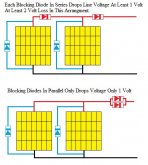
A single Bypass Diode installed on a panel looks like this in the real world....
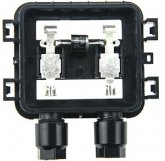
The diagram I keep seeing posted shows Blocking Diodes in Series instead of Parallel.

-------------------------------------------------------------------------------
This is why Bypass Diodes are used in the panels themselves....
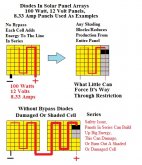
In a Parallel Panel String, the panel takes it's own self out, it simply doesn't add the line Amperage.
In a Series Panel String, the Bypass Diode does just what the name says, Bypasses the bad or non productive panel.
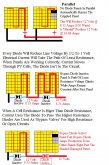
Most higher Amperage/Voltage Panels will have 2 Bypass Diodes (or more) to salvage what ever production the panel can produce.

What that look like on an actual Panel...
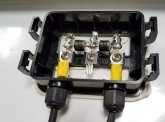
Really High Output Voltage panels might have 3 or 4 Diodes, depending on the number of cells (Voltage) or the size of cells (Amperage).

It's not uncommon for High Amp (Size Of Cell) to have Doubled (Paralleled) Diodes to carry the Higher Amperage.
Using Parallel Diodes allows any Cell String in the Panel to be bypassed and still handle the Amperage from the rest of the Panel.
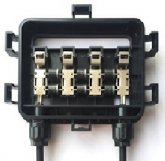
So, more than you wanted to know about Diodes, but you know how to use them if you didn't before...












